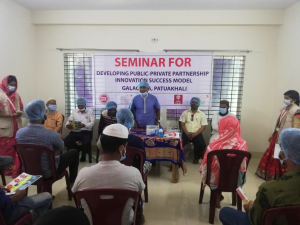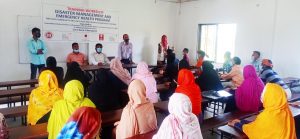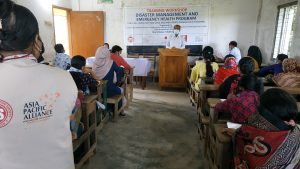
A-PAD Bangladesh Activity Report Month of August 2022
.
Project Title: Capacity Building Project for the Establishment and Sustainable Management of a Multi-Sector Platform for Disaster Management in Bangladesh
Project Period: 17 January, 2022 – 16 January, 2023 (12 month)
- Project Activities and Accomplishments
Bangladesh is one of the hazardprone countries in South Asia. Floods, droughts, landslides, thunderstorms, hurricanes and cyclones occur regularly. Among these earthquakes, floods and drought risk are extremely high. These hazards threaten millions of lives and cause large scale financial, infrastructure, agriculture and productivity losses that seriously hinder Bangladesh’s overall development. Bangladesh has limited resources and lack their own disaster management plans. Considering these problems, this paper attempts to throw light on a more integrated and responsive disaster management system in Bangladesh. Disaster Management approaches in Bangladesh harmonizing systematic inquiry of Disaster Management in Bangladesh is not well conversant in the available literature. Moreover, this approach taken from different programs at national, international and community level, which is not redeveloped, aligned with the field experiences and theoretical viewpoint.
A-PAD Bangladesh started project from January 2020 and presently continue it 17 January 2022 to build up capacity on disaster management. It communicate with the different sectors like local community, community leaders, stakeholders, GOVT. officials continuing training on disaster management. To hold training program A-PAD Bangladesh staff organized small community meeting to sharing ideas on disaster and introduced them about A-PAD Bangladesh activity. A-PAD Bangladesh working 7 divisions in last years.
There are 2 health workers in each divisions whose are doing home visit and aware the local community about basic disaster awareness. The health workers gave basic ideas about disaster management. A-PAD Bangladesh working at the rural areas. If there would be any directions or announcement from GOVT. or any disaster related news has been published the health workers delivered the message to the local community. Like Bangladesh GOVT. started vaccination program which many people did not know and some people did not interested about taking vaccine. So that the health worker visited different areas to give message about the vaccination program. Total 4,880persons were benefited from A-PAD Bangladesh on August 2022.
A-PAD Bangladesh attended coordination meeting at the 7 divisions in Office of Deputy Commissioner. At that meeting different NGOs had joined and explained their activities. Besides this what will be the next activities of the GOVT. and NGOs were discussed at that meeting.
1. To manage the emergency disaster management coordination centers in disaster-prone areas (Outcome 1) The disaster management coordination center in disaster vulnerable areas established in this project (3 year project) functions as a disaster response base in each region, and contributes for preventing the spread of health damage to local residents and community-led disaster risk reduction measures. | ||
Activities | Outcome Indicators to Measure Results: | Project Status: Achievements vs Outcome: If the activity is behind the schedule, please write the reason. |
1-1 Utilization of Emergency Disaster Management Co-ordination Center Beneficiaries: 10 persons x 25 days x 7 divisions x 12 months = 21,000 persons (Monthly Goal: 10 persons x 25 days x 7 divisions = 1,750 persons) | 【Indicators of Outcome】 1-1: The disaster management coordination center is used for coordination meetings among partner organizations and stakeholders in normal times. It will also serve as a base for health and public health guidance for localresidents. In an emergency, emergency health personnel provide health services.21,000 local residents (annual average) in the target district use the disaster response management center or receive health services. (Indicator: number of visitors, record of services provided)
1-2: Covid-19 testing lab will prevent the spread of Covid-19 infections by conducting tests. More than 9,000 Covid-19 tests will be performed and the spread of infection is reduced by dealing with residents with symptoms and those who have no symptoms but are infected nearby and are worried about infection. (Indicator: number of tests, report of test results)
| Total 3,440 people visited to the Disaster Management Coordination Center to discuss about disaster preparedness and health related issues. Dhaka: 560 Persons Cox’s Bazar: 520 Persons Pabna: 590 Persons Bagerhat: 480 Persons Patuakhali: 390 Persons Habiganj: 370 Persons Rangpur: 530 Persons Total = 3,440 Persons
|
1-2 COVID-19 awareness program in 7 divisional areas Beneficiaries:25 participants x 4 sessions x 7 divisions = 700 participants |
| |
1-3 Establish quality lab facilities to identify the COVID-19 cases Beneficiaries: 30 persons x 25 days x 12 months = 9,000 persons (Monthly Goal: 30 persons x 25 days = 750 persons) | A-PAD Bangladesh established PCR Lab for COVID-19 test. In Bangladesh number of COVID-19 patients has average in number. In August 2022 total 740 COVID-19 test has been done | |
2. To establish and strengthen the NPF Partner network (Outcome 2) A-PAD BGD, NPF for disaster reduction and disaster response through collaboration between multi-sectors, will be established and expanded, and the disaster prevention and disaster capacity of its member organizations will be strengthened. | ||
2-1 Self-assessment of networking member organization | 【Indicators of Outcome】 2-1 NPF partner organizations carry out self-assessment, and the resources of each organization are digitized. Self-assessment clarifies partner roles, responsibilities, abilities, and interests. (Indicator: List and data of resources owned by each organization)
2-2 The “Strategic Plan for Disaster Prevention, Disaster Preparation, Disaster Response, and Restoration in each district” discussed at the Strategic Meeting will be formulated, and a framework for disaster prevention cooperation will be established. (Indicator: Strategic Plan)
2-3 More than 5 organizations from new partnerships with NPF A-PAD BGD annually to expand the NPF network. (Indicator: number of new MOUs signed for 3 years)
2-4 Resources possessed by A-PAD BGD partner organizations are provided in emergency disaster response, and play the role of that organization in an emergency. (Indicator: Lists of resources such as supplies, people and donations provided by partner organizations fora three-year emergency disaster response) | Results of the Self-assessment Required document; – List of resources such as supplies, people and donations provided by partner organizations for a three-year emergency disaster response
|
2-2 Strategic Planning Network Meeting Participants:100 persons x 5 villages x 7 divisions = 3500 participants
| A-PAD Bangladesh conducted strategic planning network meeting in Cox’s Bazar.
23-08-2022,Fokir Para, Total Participants 100 24-08-2022, Sarkarpara, Total Participants 100 25-08-2022, Mamunpara, Total Participants 100 27-08-2022, Palpara, Total Participants 100 28-07-2022, Rudrapara, Total Participants 100
Cox’s Bazar is located 150km south of the divisional headquarters city of Chittagong Division. Cox’s Bazar lies on a coastal plain in the southeastern corner of Bangladesh. The plain appears to bulge out into the Bay of Bengal. Disasters like cyclones, flooding, and storm surges are becoming more frequent. CIS conducted Strategic Planning Network Meeting at 5 villages in Khurushkul Union, Cox’s Bazar Sadar. 100 participants participated in the Strategic Planning Network Meeting in each meeting. The total no of participants was 500 people who had joined the planning meeting. Participants of the strategic planning meetings were local community, community leaders, Govt. officials and NGOs.
Day -01, The topic was “Increased Awareness among the community relating to disasters. Emphasized Disasters like Cyclones, flooding, and Storm surges are becoming more frequent. Besides, Anomalistic climate patterns such as irregular heavy rainfall, High Temperature, and generally excessive humidity with distinct seasonal variations.
Day-02, The Topic was “Creating awareness on disasters among the Fishermen facing troubles during Fishing. When they go fishing in the deep sea face some troubles due to not having radios and inclement weather and are prone to accidents.
Day-03, The Topic was “Integration of risk reduction in development policies and plans”. Disaster Management plans prepared by the participants were made with the Community, which is validated by the community consultation session open for community members.
Day-04, The Topic was ”Strengthening of risk management capacities”. Discussed Any disaster Risk Reduction strategies are advised to be initiated and implemented at local level institutions, Local Govt. or local authorities are aware of local hazards, their significance, local communities and their capacities. Local authorities are very important in early warning dissemination and acting on early warning alerts.
Day-05, The Topic was “ Creation of safe and resilient communities from disasters. Natural Disaster in Bangladesh is the greatest risk for life, wealth, health and the environment. The whole process is the development of the country vulnerable to natural disaster risks of the country. The strategy for certain periods is aiming to coordinate the work of actors at the local level, Government, private organizations and the stakeholders.
Moreover, It is discussed how Strategic planning is envisioning the future of the organization, translating that vision into measurable and achievable goals and then implementing long-range planning to accomplish those goals. Strategic planning works with the ultimate goal in mind. This differs from long-term planning. Strategic planning considers overarching plans far into the future and transcends all aspects of the organization.
| |
2-3 Networking partners DRR Training Participants:25 persons x 2 org x 7 divisions x 2 times = 700 participants
|
| |
27-28 Increase NPF members and maintain partnership
| Number of new NPF member organization, number of new MOUs signed for 3 years
| |
27-29 International Symposium on DRR
Participants:200 persons | Questionaries about the symposium Required Document; Symposium Report | |
3. distriTo strengthen the local capacity for emergency response and disaster risk reduction (Outcome 3) The knowledge and abilities of human resources involved in disaster prevention and disaster response will be improved in disastervulnerable areas, contributing to the strengthening of disaster response capacity building of local communities. | ||
3-1 a) Workshop on Disaster Management and Emergency Health Program
Participants:50 persons x 7 divisions x 2 times = 700 persons | 【Indicator of Outcome】 3-1 a) Build a network of community leaders who can lead disaster response and emergency health response in all districts in Bangladesh. (Indicator: number of community leaders who can lead emergency response, list of community leaders for disaster response/emergency health in all 7 districts. (3 years))
b) Network of human resources with skills and know-how to health response in an emergency will be established in all districts in Bangladesh to provide health services to local residents in an emergency.(Indicator: data of 25 NGO health response personals who can respond in an emergency, cases of activities during an emergency disaster in all districts, and the number of residents provided with services (3 years))
3-2 Disaster information and emergency response records are accumulated as a disaster archive. In addition, the activities and results of this project of A-PAD BGD will be introduced at international symposiums, internationalorganizations, and domestic and foreign media. (Indicator: situation report at the time of disaster, number of activity reports posted on A-PAD BGD website, international symposium report, introductory article) | Three days training workshop sad been done in the 2 divisional areas Dhaka and Bagerhatwhere 50 participants had joined.
13-14 & 16 August 2022, Dhaka, Total Participants 50 27-29 August 2022, Bagerhat, Total Participants 50
Common outbreaks include cholera, dengue fever, and diphtheria, while typical natural hazards include floods, cyclones, storm surges, riverbank erosion, earthquakes, droughts, landslides, salinity intrusions, and fires. Due to the geographical setting of the country’s south and northeast regions, which are characterized by hilly areas and upstream rivers, Bangladesh is more prone to cyclones, flash floods, and landslides. Overall, of the country’s 147,570 square kilometers (56,980 square miles), 97.1 percent are highly vulnerable to two or more hazards. That puts 97.7 percent of the population at risk of health emergencies, including those due to outbreaks of infectious diseases that typically follow natural disasters. A-PAD Bangladesh has focused attention on resilience building, including establishing appropriate EWS. As a result, the health consequences of natural hazards such as floods and cyclones are reported to have reduced significantly over the past 40 years due not only effective EWS, but also increased political commitment to disaster preparedness and risk reduction, increasing activities of international development partners and NGOs in DRM, and increased levels of community mobilization for DRM. The GoB has also prioritized health security on its development agenda, as evidenced by establishment of a functional national One Health Initiative, in line with the country’s priority to adopt a multisectoral approach in response to biological hazards. · Cyclone Preparedness Program EWS scaled up into a multi-hazard program to address different natural disasters. · Integration of EWSs that monitor and provide early warning of extreme weather events into emergency preparedness systems.
Bagerhat District is a district in Southwestern Bangladesh. It is a part of the Khulna Division. Among these 64 districts, the Bagerhat district is a more disaster-prone area. For geographic location and weather conditions, cyclones, tidal floods, erratic rainfall, cold wave, arsenic contamination, and tornado are common in this area. The Workshop on Disaster Management and Emergency Health Program workshop was held to identify, assess, and address these opportunities and challenges. The main focus of the training workshop was on building up capacity for emergency response during and after a disaster. CIS conducted a training program in Sharankhola, Bagerhat on 27, 28 and 29th August -2022 three days. On the 1st day, Dr. GM Shaid is about Discusses, Blood Pressure and Heart attack, Public Health aspects of basic knowledge which is necessary for emergency help. on the 2nd day, there was a discussion on Diarrhea and the existing early warning system in sharankhola. Participants shared their opinion on existing early warning techniques and shared that technology can play an important role in the early warning system and rural people should know using technology. On 3rd day the topic was emergency help in primary healthcare during a natural disaster and what is a man-made disaster and how we can avoid hazard-related issues and how can a community be resilience and cope with disasters.
|
3-1 b) Local NGO Emergency Health providers training
Participants:25 pers/time x 7 divisions = 175 persons |
| |
3-2 Seminar for Developing public-private partnership innovation success models
Participants:50persons x 7divisions x 2times =700participant | A-PAD Bangladesh conducted public private partnership seminar at Habiganj and pabna. 50 participants had joined in each division. 23 August 2022, Habiganj, Total Participants 50 29 August 2022, Pabna, Total Participants 50
Bangladesh is ranking as one of the most disaster-prone countries. People in Bangladesh are often affected by water-related natural disasters, including floods, riverbank erosion and cyclones. In addition, recent rapid urbanization increases the risks for earthquake as well as man-made disasters.CIS Conducted seminar in Habiganj and this Public-Private Seminar was attended by Local Government Authorities, NGO Representative, community leader and People’s Committees who directly involve in Disaster Risk Management processes. This seminar aimed at facilitating knowledge exchange between Public-Private practitioners to strengthen their skills and help to improve the performance of the Public-Private Partnership platforms they are engaged in. It also helped to build capacity of participants to effectively manage and monitor a Public-Private Partnership process. During the discussions, the participants explored how the government, private sector and civil society organizations can effectively use Public-Private Partnership platforms to identify the most effective means to support the full participation of beneficiaries, stakeholders, NGO and Government sector. Public-Private Partnership (PPP) is a common practice in both the public and private sectors. PPP has been an important instrument to achieve Sustainable Development Goals (SDGs) at the national level. Partnership as a concept implies joint and voluntary endeavors toward a common purpose. Therefore, the partnership is about sharing power, responsibility, and achievements conceptualized partnership as a kind of relationship between individuals and groups to accomplish a common goal. Partnerships enable the sharing of experiences, knowledge, skills, technology, and financial resources to materialize concrete actions for sustainable development has outlined partnership models including the autonomous model, the independence model, the globalization-convergence model, the hybrid model, and the elite model. Each of these models includes alternative premises, strategies and global frameworks. However, the bedrock elements of any form of a partnership are mutual dependence, respect, and trust, as well as accountability and transparency. Therefore, partnerships can take many forms of collaboration; partnerships with businesses, academia, NGOs, and international organizations. The PPP is expected to complement governments’ efforts at the national and sub national/ local levels. Developing state-NGO partnerships to ensure the delivery of basic social services to all in the developing world is integral to contemporary development thinking. The government of Bangladesh has introduced PPP in 1996 after approving the private sector power generation policy of Bangladesh to facilitate the development of public infrastructure and services. This seminar helped the people of Habiganj to know more about Govt. activities and there are scope for working together to fight against disaster and save lives.
Pabna is one of the old districts in Bangladesh. The main disaster in this area in Floods, cyclones, thundering, uncontrolled rainfall and fires. The main focus of the training workshop was on building up capacity for emergency response during and after a disaster. CIS conducted a training program in Pabna on 29 August 2022. local community, community leaders, local NGO’s and non-governmental organizations attended the seminar. The main focus of the training Seminar is on public-private partnerships. in this seminar MdRashedulKabir, Deputy Director District SomajSeba officer, MdRofiqul Islam agriculture officer Bangladesh Agriculture Development Corporation (BADC) PabnasadarPabna was present and they shared their valuable opinion on disaster management and public-private partnership. Public and private sector partners can improve their understanding of each other’s preparedness responsibilities, procedures, priorities, and capabilities through education, training, and technical assistance. Public and private sector partners can work together to incorporate partners’ risks, vulnerabilities, and capabilities into joint plans. The joint planning process allows the public and private sectors to coordinate efforts and resources to prevent, mitigate, respond to, and recover from disasters. In this seminar, they also discussed PRA (Participatory rural appraisal) and the importance of Community based disaster management system. the idea of the participatory approach is to discover solutions to problems from participants or local communities through participatory techniques. The motivation for participation by local people is that beneficiary involvement makes projects more likely to succeed in meeting their objectives. A good participatory approach improves motivation, increases learning and feelings of ownership and enables community empowerment. Raising awareness about the water or sanitation issues, enables the users to make an ‘informed choice’ about what will become their system. The benefits of implementing PRA are
| |
3-3 Update website contents as E-resources for Disaster Management | https://cis-bd.org/2022/08/14/cis-visited-srilanka-and-provided-emergency-life-saving-medicine/ https://apad-bd.org/wp-content/uploads/2022/08/hobiganj-flood-paper-cutting2.jpg | |
- Challenges
- Practice in collaboration with A-PAD Bangladesh Network Partners
Please write good practice in collaboration with partner organizations
- Any contribution Funds Received and Grants Applied / Planned and Implemented Projects by CIS including Emergency Response
Please write Projects name and its fund resources
- Relationship with Bangladesh Government and Japanese Embassy
Please write about Meeting with Government officials
Strategic Planning Network Meeting-Cox’s Bazar
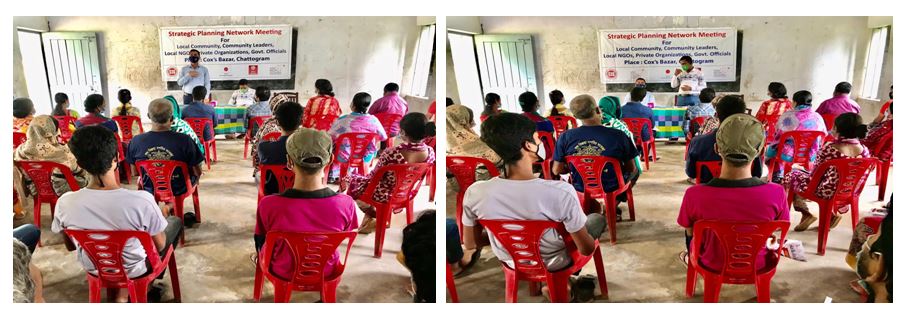
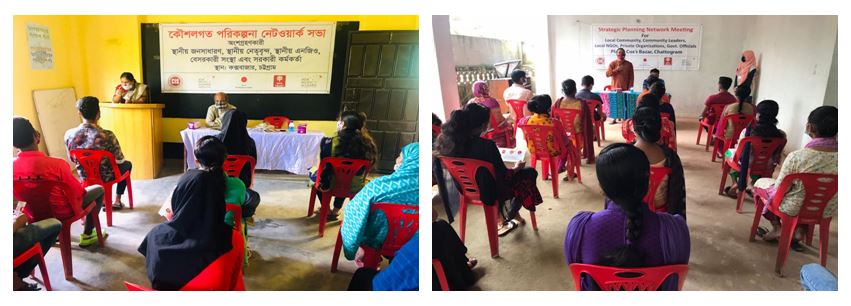
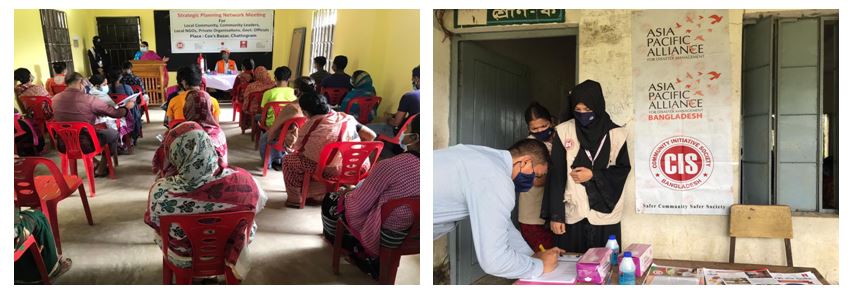
Workshop on Disaster Management and Emergency Health Program-Dhaka

Workshop on Disaster Management and Emergency Health Program-Bagherhat
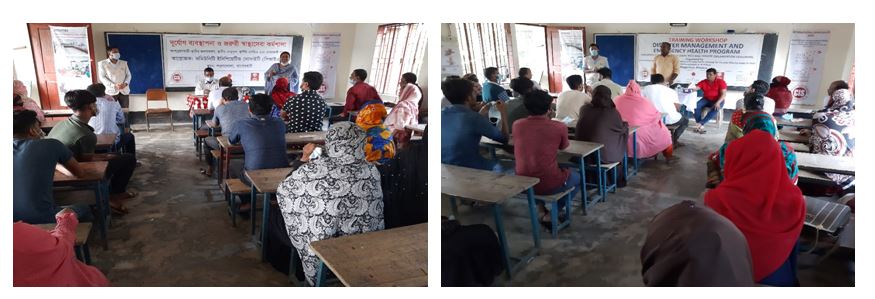
Public Private Partnership Seminar-Pabna

